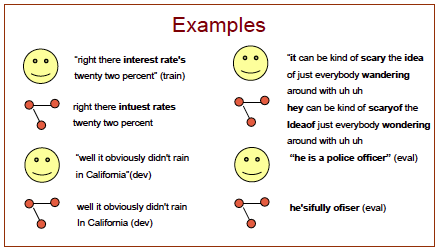End to End Speech Recognition
The summer after my sophomore year, I was introduced to deep learning for the first time and got to train end to end RNNs for speech recognition. This was part of my CURIS project in the Andrew Ng Deep Learning Lab.
Speech recogniton is an important subfield of machine learning with vast applicability to human computer interacton, telephone and audio transcripton, etc – popular examples include Siri, Nuance, and Google Now. However, due to variance in speaking styles, transcribing human-human conversatons is challenging. Traditonal algorithms (Hidden Markov models, Gaussian mixture models/RNNs) require an extra step of determining which window of speech corresponds to which English word. However, these alignments are not readily available leading to a complicated error prone cycle of alignment generaton and training. In Connectionist Temporal Classifcaton (CTC) [1], a recurrent neural network is trained to output characters directly from speech features, without relying on any additonal inputs or alignments, making it invariant to speaker-to-speaker diferences. By training on large networks (deep learning) and many hours of speech, we allow our models to learn the nuances of speech without having to provide features from domain specifc knowledge and be wholly data driven.
Thanks to Awni Hannun, Andrew Maas, Ziang Xie, Peng Qiu, and Andrew Ng for their mentorship and help. Over the summer, I:
-
Trained RNNs on Wall Street Journal Corpus (~81 hours, news reading) and Switchboard Corpus (~300 hours, telephone conversatons)
-
Implemented dropout and investigated effect of different feature sets (mel flter bank cepstral coefcients, filter banks, context windows for past/future informaton) on Wall Street Journal performance
-
Built a confgurable feature pipeline to easily create many different training sets and worked on an internal neural network experiment manager to easily conduct many deep learning experiments on cluster computers.

Poster here.
[1] Graves, A., Fernandez, S., Gomez, F., and Schmidhuber, J. Connectonist temporal classifcaton: Labeling unsegmented sequence data with recurrent neural networks. In ICML, pp. 369–376. ACM, 2006.


